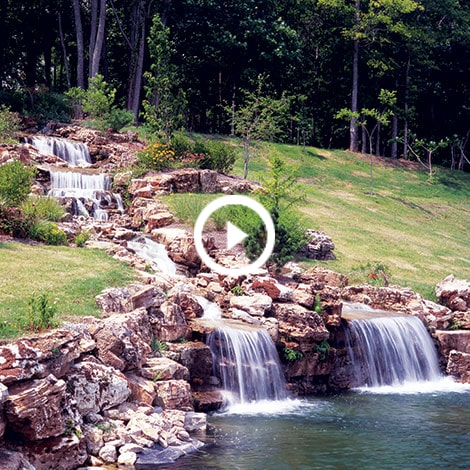A pump is like the heart of your pond, it circulates the water and moves it through your filtration unit, spitter, or waterfall. Selecting the right pump for the job will ensure that your water is filtered properly, and your water feature is looking its best. When doing your shopping, here are some things to consider:
Application
Are looking to send water cascading over a waterfall or run a small fountain or send water through a UV clarifier?
- Fountains or Spitters typically require a smaller pump. Look for pumps in our Fountain & Spitter Pump category.
- Waterfalls require a few more calculations to determine the size needed. See below for more information on sizing a waterfall pump. We have a wide variety of Waterfall Pumps available to get the flow you want.
- UV Clarifiers or Pressure Filters typically have a recommended pump size for optimal use. Check your manual or the product page to determine what pump size is recommended but note that head pressure will come into play (see below)
Minimum Pump Size
Water needs to circulate through the filter at least once every 2 hours. This means that if you have a 1,000-gallon pond, you need a pump that can produce at least 500 gallons per hour or GPH. If you have fish, then it is best to double the pump's capacity to ensure that your water stays clean. A common misconception is that pump size is only related to pond size; however, the size of a waterfall, stream, or fountain is typically the deciding factor for which pump will be best in your feature.
Measurements Needed
Head pressure and desired flow rate will influence the pump needed to power your water feature. Head pressure refers to the friction created when water is pumped uphill or over long distances. Flow rate will determine how much water moves through the feature. Below are some tips for calculating these measurements:
- Head Pressure: A combination of the vertical distance from the water surface to the top of the waterfall and length of tubing. A foot of vertical height or 10' of tubing is equivalent to 1' of head pressure. Therefore, a feature that is 3' tall with 16' of tubing would have 5' of head pressure.
- Flow Rate: The average amount of water moving over a waterfall is 1,500 GPH for every 1' of width. Therefore, a waterfall that is 2' wide would need a 3,000 GPH pump. If you are looking for a heavier flow, calculate your flow using 2,000 GPH per foot.
- Putting It Together: You may have noticed that our pumps have the flow rates listed different head pressures, so you just have to match up the numbers. In our example, if you wanted your feature to have a heavy flow then you would need a pump that can produce about 4,000 GPH at 5' of head pressure. The Pond Guy RapidFlo – 4,000 GPH would be the perfect fit because at 5' of head pressure, this pump produces 3,900 GPH.
Types of Pumps
There are two classes of pumps, submersible and external. For ponds, submersible pumps are preferred because they can be hidden easily and used in skimmer boxes. There are several varieties of pumps available, so below is guide to help you determine which one is right for you.
- Mag-Drive: Ideal for small to medium applications, such as spitters and small in-pond filtration units. The Pond Guy MagFlo and other pumps of this style operate by a magnetic impeller. These are usually long-lived and generally only a new impeller is needed to refresh the pump.
- Asynchronous and Hybrid: These have a higher flow rate at lower head pressures and are perfect for medium to larger applications. Asynchronous and hybrid pumps, like the Atlantic Tidal Wave3 TT-Series and Blue Thumb IllumiFlow, have a long life span, performing like direct drives, but energy efficient like mag-drives.
- Direct Drive: The ShinMaywa Norus Submersible and other direct drive pumps are designed for features with a high head pressure and flow rate. Most models require oil or lubrication changes to keep the impeller shaft moving properly. These pumps have fewer moving parts, making them more economical to purchase; however, they have a shorter lifespan than the other style of pumps.
Click here if you are still not sure what pump is right for your pond or water feature? Give us a call at 866-766-3435. We're happy to help!
Last Updated: February 10, 2023



